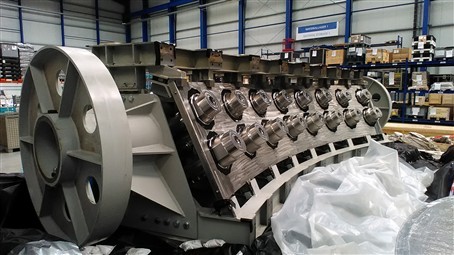Further subassemblies for Vacuum Vessel sectors completed


Further segment subassemblies for ITER’s vacuum vessel for sectors 5, 4 and 3 have been completed. The companies within the AMW consortium: Ansaldo Nucleare, Mangiarotti and Walter Tosto, together with their sub-suppliers ENSA and Pro-beam, have successfully worked together to produce these segment subassemblies which marks a big step towards reaching the final assemblies of the segments.
The completed subassemblies, which weight ranges from 1400 to 11000 kg, form part of 3 of the 5 sectors which make up Europe’s contribution to ITER. Each of these sectors will measure 6.5 metres high, 3 metres wide and 6.3 metres deep and will weigh around 500 tonnes.
The first part of the manufacturing process – cutting and rolling of the plates of the inner shell (the part of the vacuum vessel which will be closest to the plasma in ITER) – was carried out by Walter Tosto. The plates of the inner shell for the first and fourth segments were then transported to Mangiarotti and ENSA, while Walter Tosto kept those for the second and third segments. The next step carried out at these three workshops was the cutting and machining of the holes which will house the so-called flexible housings (cylindrical parts which act as bolts) and the intermodular keys (parts which are used to align interfacing components). Due to the size of the inner shell plates (up to 6 metres long, 1.5 metres wide, and 60 millimetres thick), large milling machines were used to make the holes for the flexible housings and the intermodular keys. These plates, made up of the special ITER grade stainless steel, are flat stainless steel slabs which have been rolled flat and which will be used to manufacture the inner shell which will make up the inner walls of vacuum vessel sectors.
The positioning operation and assembling of inner shell plates with the T-ribs (the part of the sector which will be curved) and the intermodular keys entails a number of challenging steps. This is due to the narrow gap allowed by electron beam welding between the two parts to be welded, known as the welding gap. In this case, this gap needs to be as narrow as 0.6 to 0.8 mm. An additional challenge is the flatness tolerance (the allowed limit or limits of variation in the overall flatness of each plate) and general dimensional tolerance, which are both extremely tight in order to keep gap and misalignment between parts within the maximum acceptable limit of electron beam welding.
A wide variety of inspection techniques were applied in order to check for potential defects and carry out measurements without causing any damage to the parts themselves (known as Non-destructive Examination – NDE). These inspection techniques demonstrated that despite the large size of the plates, the necessary dimensional tolerance had been achieved.
After positioning the plates and ribs on the customised support structures, the so-called jigs, the initial welding operation (the root pass) was manually performed at the respective Mangiarotti, Walter Tosto and ENSA workshops. Subsequently the assemblies were transported to Pro-beam, to perform electron-beam welding of the full thickness. The conclusion of the electron-beam welding, together with its related inspection, marked the completion of each of the subassemblies.

“The Vacuum Vessel Central Team has coordinated the interface management work needed to prepare the mentioned manufacturing activities and has worked very efficiently to make this a success”, says Francesco Zacchia, F4E Project Manager for the Vacuum Vessel Team “Thanks to good team work there, we continue to deliver and solve any arising problems”, he notes.
“As production of single parts of the segments of vacuum vessel sectors is well advanced, we are now moving full-steam ahead into the next technically challenging phase of assembling different parts into segment subassemblies, whilst staying within the required dimensional tolerances”, says Gianfranco Savoldi, Vacuum Vessel Contract Project Director for the AMW consortium.
On a further positive note, an inspection of the French Nuclear Safety Authorities (ASN) in Walter Tosto, with the presence of ITER IO, F4E and AMW, reviewing in detail, among other things, the correct application of the manufacturing procedures and also the level of Nuclear Safety culture, was recently satisfactorily concluded. “We are obviously proud and happy to achieve this good success and we continue to engage in continuously improving and developing the nuclear safety culture in our work”, said Francesco Zacchia.
